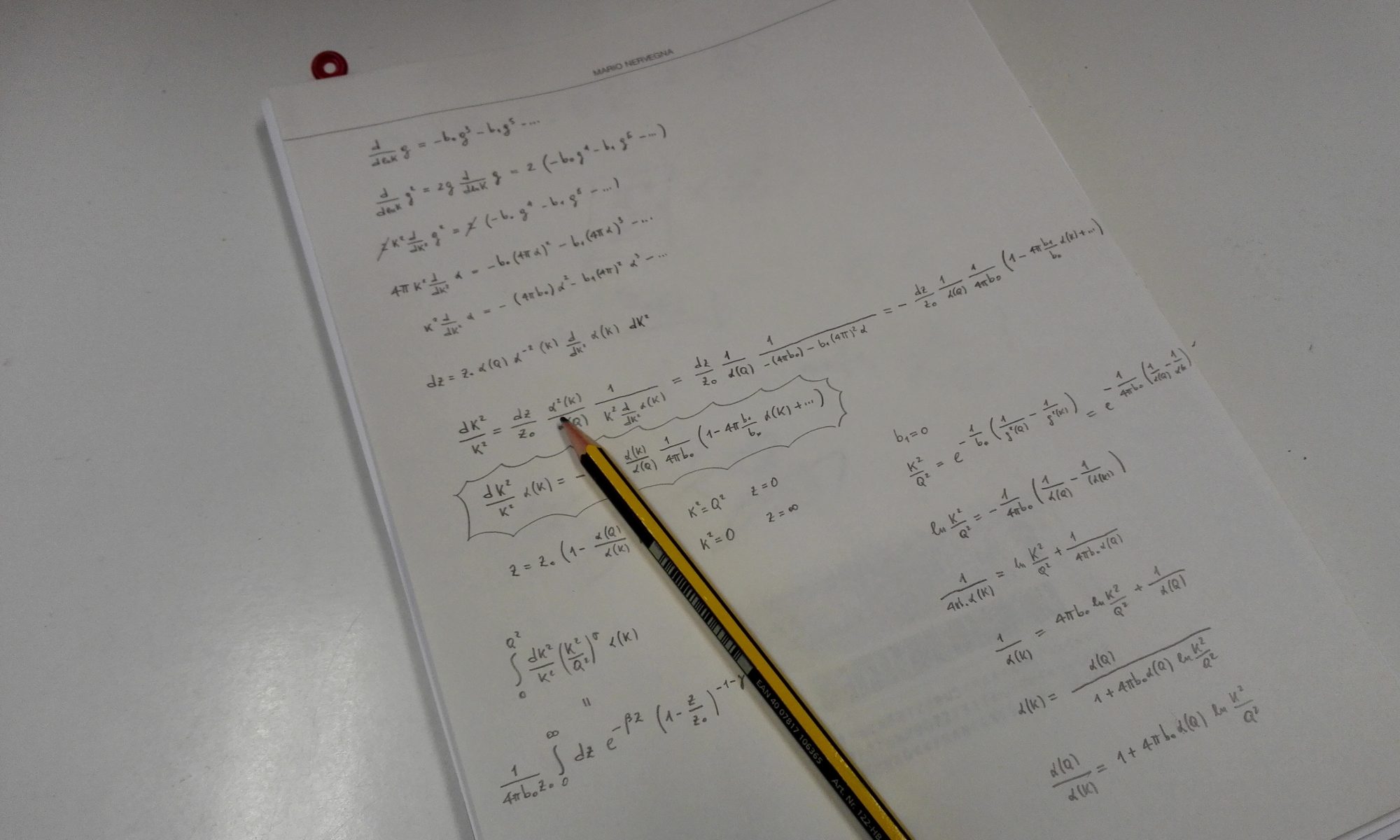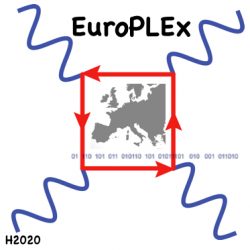Paul Dirac: when the beauty surpasses the scientific method
by Nico Battelli (EuroPLEx fellow, Trinity College Dublin)
Berlin, 23 August 1926
Dear Ehrenfest,
[…]
I am toiling over Dirac. This balancing on a dizzying path between genius and insanity is terrible. Nothing that one can grasp firmly in hand! Best wishes for a happy vacation to you and yours from your
Einstein
In this letter to the physicist Paul Ehrenfest, Albert Einstein complained about the unintelligibility of Paul Dirac’s recent work on Quantum Mechanics.
Let us take a step back: we are at the end of July 1925, at the library of St. John’s College in Cambridge, where a small group of students is engaged in the study of the theory of Special Relativity, Paul Dirac announces to the tutor Sir Ralph Howard Fowler that he has found the solution to the “significant difficulty” of the new theory, defined as such by Werner Heisenberg in an article published in “Zeitschrift für Physik” entitled “Quantum theoretical reinterpretation of kinematic and mechanical relations”: the product of two quantum quantities does not enjoy the commutative property of multiplication, i.e. it depends on the order of the factors.
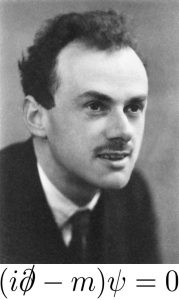 Paul Adrien Maurice Dirac (and the famous Dirac equation).
Paul Adrien Maurice Dirac (and the famous Dirac equation).
He was on one of his usual long Sunday walks in the countryside when “the idea first came in a flash – out of the blue … [that] there seemed to be a close similarity between a Poisson bracket of two quantities and their commutator, … I had some vague recollections” It was Sunday, all libraries were closed in the college, so he had to wait “impatiently through the night” until Monday morning when the libraries opened, “I looked up Poisson brackets … and found that they were just what I needed.” In that year Dirac got his PhD degree with a thesis on Quantum Mechanics, the theory was before introduced by Heisenberg in a paper in early 1925. Dirac’s work was a development of the same theory from a different point of view.
“It is not the equations of classical mechanics that are in any way at fault, but that the mathematical operations by which physical results are deduced from them require modification. All the information supplied by the classical theory can thus be made use of in the new theory.” With these words, in the preface of “The Fundamental Equations of Quantum Mechanics” (1925), Dirac introduced the concept of “Quantum Algebra”. Dirac discovered the “canonical quantization” which is a procedure for quantizing a classical theory, while attempting to preserve the formal structure, such as symmetries, of the classical theory, to the greatest extent possible. The extension of the classical Poisson brackets of analytical mechanics to a new structure called “commutator”: the product of two quantities A and B can have different values if you do the multiplication in the order AB or in the other way round BA.
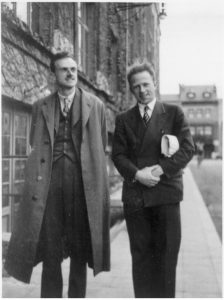 Dirac (left) with Heisenberg in 1930.
Dirac (left) with Heisenberg in 1930.
This first paper by Dirac was submitted to the Royal Society on November 7, 1925. Dirac and his supervisor Fowler did not know that in Germany other physicists working on Quantum Mechanics, Max Born and Pasqual Jordan, had submitted a paper with the same results more than one month before: Born & Jordan, and Dirac, independently discovered canonical quantization.
At that time the main works on Quantum Mechanics were produced by a small group of physicists in Germany and Copenhagen, which was the beating heart of this new theory. From that lands Born, Heisenberg, Kramers, Pauli and Bohr worked closely and continuously together; British contributions to the quantum theory were poor until 1925. Dirac was not only isolated by geographical reasons but also because his own peculiar personality, the extreme reluctance to speak: the Cambridge colleagues had coined the “dirac”, a unit of measure for talkativeness; in their intentions a dirac was equivalent to the emission of one word every hour. When the first work of Dirac arrived in Germany, there was a total surprise among all the quantum physicists; later Max Born recalled this “as one of the great surprises of my scientific life, for the name Dirac was completely unknown to me”, Dirac was only 23 years old. Paul Adrien Maurice Dirac was born in Bristol, England on August 8, 1902, into a family of Swiss origin: his father Charles, a French teacher, his mother Florence, the daughter of a vessel commander, and two other brothers. He received a rigid and hard education, due to his father’s authoritarian tendencies, but from an early age he showed an excellent predisposition for mathematics and at the age of 12 he enrolled at Merchant Venturers Technical College, a modern technical-scientific school. Subsequently he enrolled at the Engineering College of the University of Bristol to complete electrical engineering studies and then in applied mathematics as a revenge against the father who wanted him as a linguist “I owe a lot to my engineering training because it [taught] me to tolerate approximations. Previously to that I thought…one should just concentrate on exact equations all the time. Then I got the idea that in the actual world all our equations are only approximate. We must just tend to greater and greater accuracy. In spite of the equations being approximate, they can be beautiful.”
How much can beauty be trusted? There is a beauty of the laws of nature that things respect and scientists are discovering. It is beauty but, just saying, ordinary. And there is a beauty superordinate to the first, the beauty that the same laws of nature must respect. An extraordinary beauty. In our case that of symmetry: “… Schrodinger and I both had every strong appreciation of mathematical beauty, and this appreciation of mathematical beauty dominated all our work. It was a sort of act of faith with us that any equations which describe the fundamental laws of Nature must have great mathematical beauty in them. It was like a religion with us. It was a very profitable religion to hold, and can be considered the basis of much of our success.” This was just the beginning of a concept which Dirac always carried with him and which will lead to unexpected future results.
In June 1927 Paul Dirac began to dedicate himself to the project of combining the two theories of the new physics, Quantum Mechanics and Special Relativity, to obtain an equation of motion for the particles that is also valid at velocities close to that of the light. The first equation of this type, which appeared in the literature by Oskar Klein and Walter Gordon, had the defect of providing negative probabilities and of being incompatible with the formulation of Quantum Mechanics that Dirac himself had developed.
In these two episodes (the work in 1925 and the search for a new equation in 1927) in the life of one of the most courageous and, at the same time taciturn, English mathematicians of the last century, the aspiration for knowledge, independence of thought (“playing with equations and seeing what they give”) are summarized together with the ability to combine at least three areas normally separated from each other: mathematics, physics and beauty (“The models of a mathematician, like those of a painter or a poet, must be beautiful: ideas, like colors or words, they must be linked in a harmonious way. Beauty is the basic requirement: there is no place in the world for bad mathematics.”) The Dirac equation, born from purely theoretical considerations, perfectly explains the motion and properties of electrons, including their intrinsic rotational moment, spin, the description of which had required up to rather artificial hypotheses at the time. It is the key discovery of Dirac’s entire existence, and it already contains all the elements that made him famous, it represents its ideogram. In 1931, with the extraordinary article “Quantised Singularities in the Electromagnetic Field” Dirac predicted the existence and properties of a new particle “….this would be a new kind of particle, unknown to experimental physics, having the same mass and opposite charge as the electron. We may call such a particle an anti-electron (positron later).” It required courage on the part of Dirac to pursue the theory of an undetected particle and the first example of antimatter!
At first, Dirac did not appreciate the significance of this finding, and even ignored it out of what he would call “pure cowardice” in a future discussion when Murray Gell-Mann asked why he had not predicted the positron immediately.
The positron, was later confirmed through cosmic rays experiments in 1932. In a commemorative volume to James Clerk Maxwell (1931), Einstein will change his original opinion on Dirac and say “[…] Dirac, to whom, in my opinion, we owe the most logically perfect presentation of Quantum Mechanics […]”.
Paul Dirac will win the Nobel prize in 1933 jointly to Erwin Schrödinger for the discovery of new productive forms of atomic theory. As someone who actively avoided any kind of attention, he was inclined to refuse the prize because he did not like publicity, but then he accepted when Sir Ernest Rutherford told him: “a refusal will get you much more publicity”.
1946, Princeton University: many years had passed since that memorable day. It was the Princeton’s Bicentennial Celebration, a young physicist who was working on Dirac’s theories, Richard Feynman, met his hero Dirac for the first time and they had the following conversation:
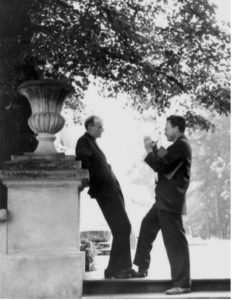 Dirac (left) with Feynman in 1946.
Dirac (left) with Feynman in 1946.
– I am Feynman.
– I am Dirac.
– It must be wonderful to be the discoverer of that equation.
– That was a long time ago. What are you working on?
– Mesons.
– Are you trying to discover an equation for them?
– It is very hard.
– One must try.
None could know or even imagine what Feynman would do shortly. Feynman gave a lecture on a nascent “Alternative Formulation of Quantum Electrodynamics”, reformulating the theory which had earned Dirac the Nobel Prize in Physics in 1933. Feynman received the Nobel prize in 1965 jointly with Julian Schwinger and Sin-Itiro Tomonaga “for their fundamental work in quantum electrodynamics, with deep-ploughing consequences for the physics of elementary particles.” But this is another beautiful story.
Sources:
– “La bellezza come metodo”, Vincenzo Barone.
– “The Strangest Man: The Hidden Life of Paul Dirac”, Graham
Farmelo.
– “Quantum”, Manjit Kumar.
– “The collected papers of Albert Einstein”, https://einsteinpapers.press.princeton.edu
– “P.A.M. Dirac and the Discovery of Quantum Mechanics”, Kurt Gottfried (arXiv: 1006.4610v1)
Original story translated with permission from Investigación y Ciencia.
